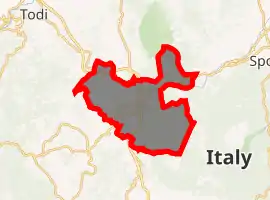Acquasparta
Acquasparta is a town and comune in the province of Terni (Umbria, central Italy). It is located on a hill above the Naia Valley and the river of the same name, facing the Monti Martani mountain range.
Acquasparta | |
|---|---|
| Comune di Acquasparta | |
 | |
Location of Acquasparta 
| |
 Acquasparta Location of Acquasparta in Italy  Acquasparta Acquasparta (Umbria) | |
| Coordinates: 42°41′N 12°33′E | |
| Country | Italy |
| Region | Umbria |
| Province | Terni (TR) |
| Frazioni | Casigliano, Casteldelmonte, Cisterna, Collebianco, Configni, Firenzuola, Macerino, Portaria, Rosaro, Selvarelle Alte, Selvarelle Basse |
| Government | |
| • Mayor | Roberto Romani |
| Area | |
| • Total | 79 km2 (31 sq mi) |
| Elevation | 320 m (1,050 ft) |
| Population (30 April 2017)[2] | |
| • Total | 4,684 |
| • Density | 59/km2 (150/sq mi) |
| Demonym(s) | Acquaspartani |
| Time zone | UTC+1 (CET) |
| • Summer (DST) | UTC+2 (CEST) |
| Postal code | 05021 |
| Dialing code | 0744 |
| Patron saint | Saint Cecilia |
| Website | Official website |
It also sits between two hot springs, the Amerino and the Furapane.
History
The name's origin is traditionally connected to the Roman toponym of Aquas Partas ("divided waters" or "between the waters"), about which, however, no documentation exists. More probably, the name born from the presence of several different water sources in the area.
During the ancient Roman domination the area was a retreat - a spa whose mineralized hot water baths were easily accessible from Rome along the west branch of the via Flaminia. Thermal baths remain open to the public today.
The city was later part of the Terre Arnolfe, and was later subjected to Todi. Subsequently, in 1588, it became a fief of the Cesi family.
Main sights
Its historical center at once was surrounded by medieval walls but, now mostly torn down, leaving only short stretches and a few cylindrical towers that at one time served as part of the town's defenses.
Inside the old part of town, which is quiet and unprepossessing, the principal building of note is the Renaissance style Palazzo Cesi, started in 1564 and completed in 1579 by the architect Giovanni Domenico Bianchi. The Palazzo is owned by the University of Perugia and is in very poor, but improving, condition. The main portal includes some fine ashlar work and its interior features impressive carved wooden ceilings. It also possesses a capacious and delightful courtyard. Next to the Palazzo is a loggia with some remnants of Roman foundations.
At once, the Palazzo's proprietor, Federico Cesi, housed the scientifically oriented Accademia dei Lincei here, attracting such teachers as Galileo Galilei. Today the Cesi's palazzo a small museum with a number of ancient artefacts, including Roman stone work from nearby Carsulae. The facility is also used for meetings and traveling exhibitions.
Acquasparta is home to a number of churches, including San Francesco, built in 1290, essentially Romanesque but with a Gothic architecture facade, and the Church of the Madonna of the Cross, dating to 1606. The Church of the Sacred Sacrament, incorporating a Roman Mosaic in its floor, is a very good example of 17th century church architecture. Santa Cecilia, built in the 16th century, contains an elegant chapel in which lies the tomb of Federico Cesi.
The surrounding countryside is charming in the Umbrian way, spotted with a few small castles such as the one at Configni. Of note a short way from Acquasparta is the church of San Giovanni de Butris, which was built on the remains of a Roman bridge, and incorporates very large Roman stone blocks. Also, along the via Flaminia, going north, is the ruins of another Roman bridge, the Ponte Fonnaia.
References
- "Superficie di Comuni Province e Regioni italiane al 9 ottobre 2011". Istat. Retrieved 16 March 2019.
- "Popolazione Residente al 1° Gennaio 2018". Istat. Retrieved 16 March 2019.
